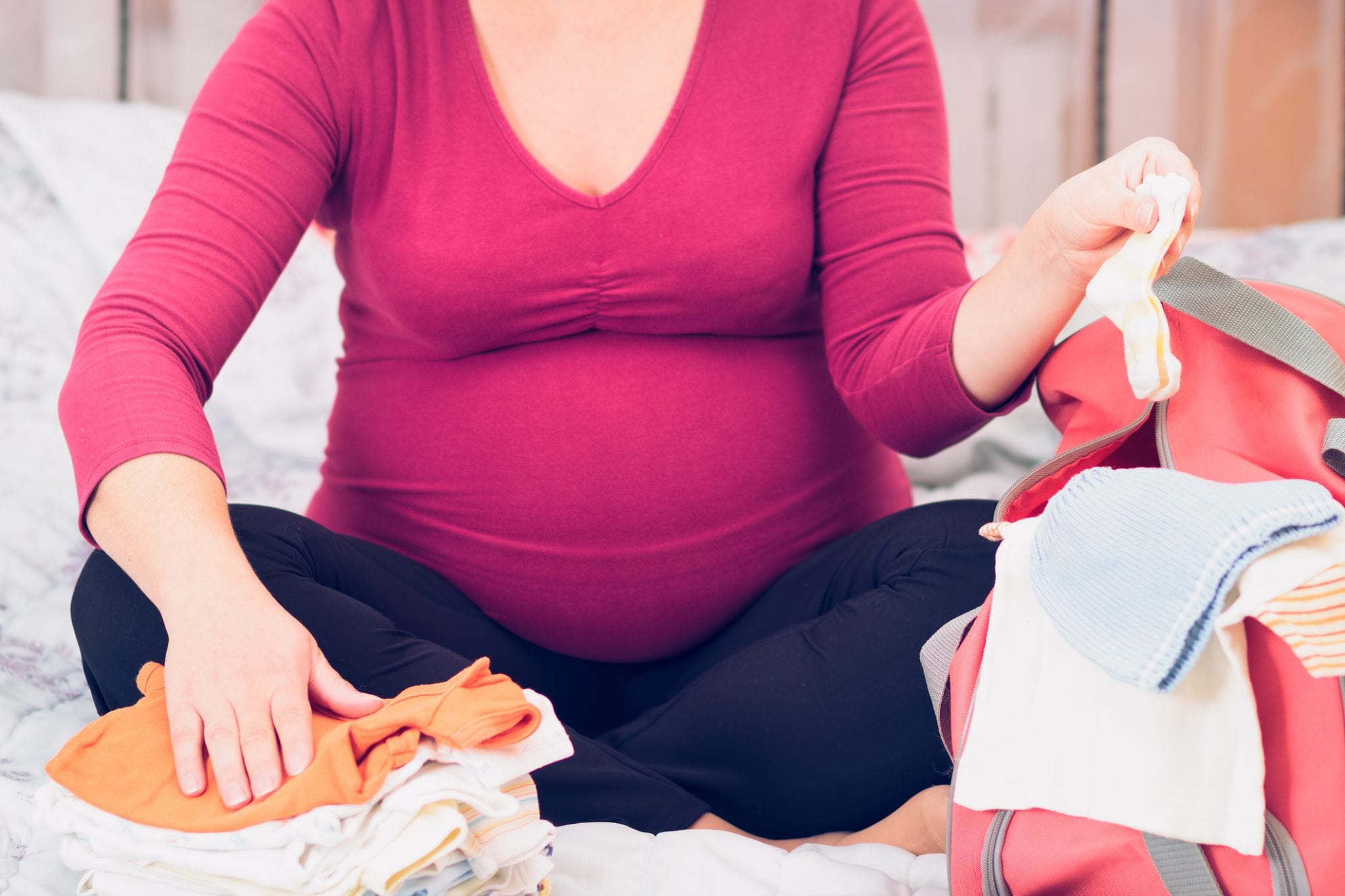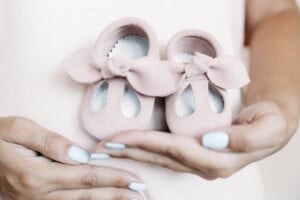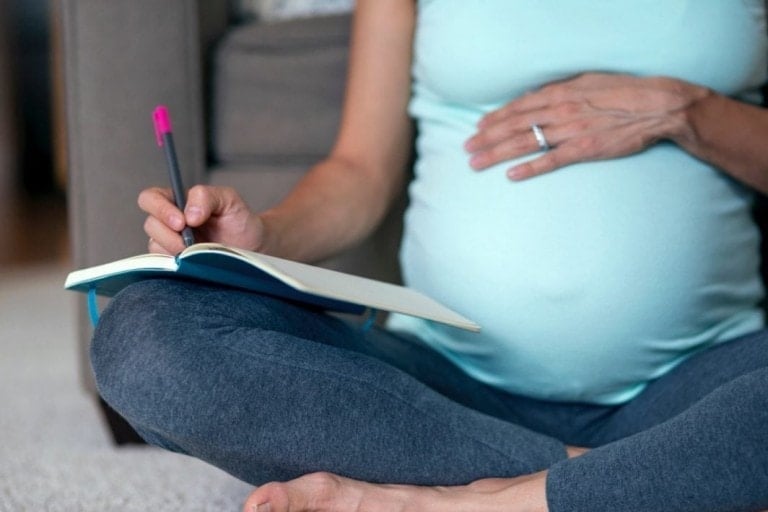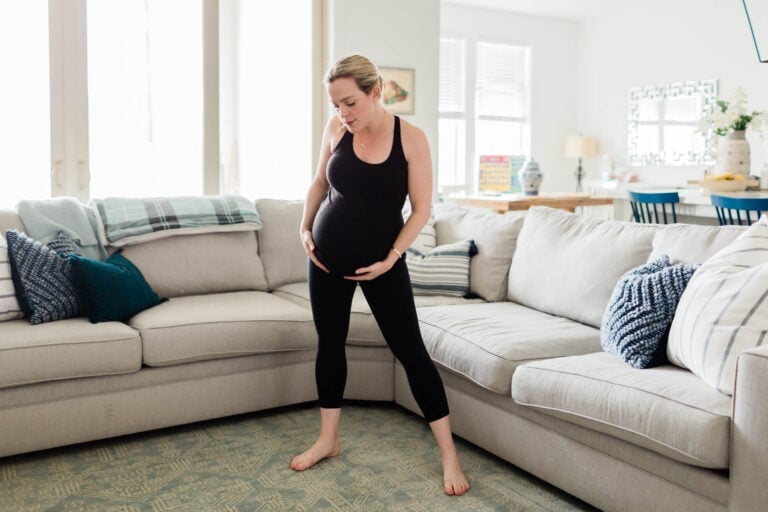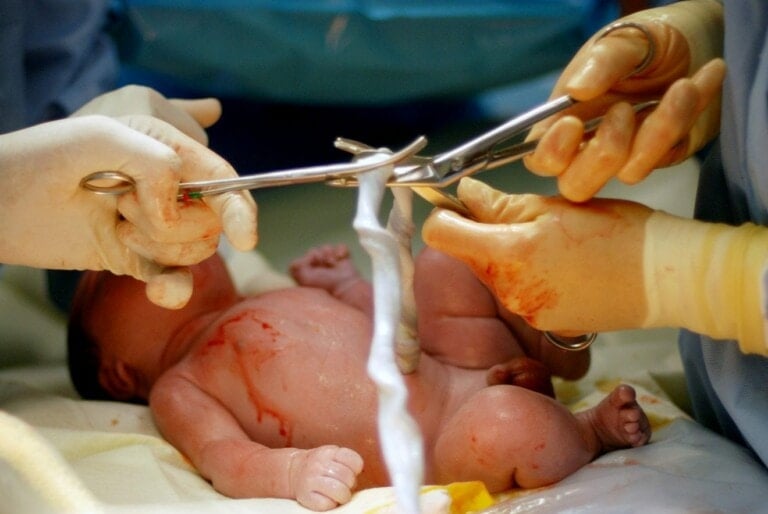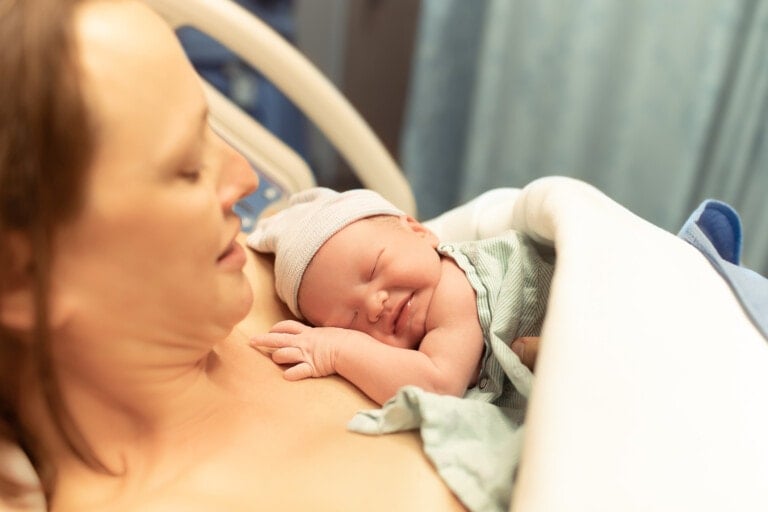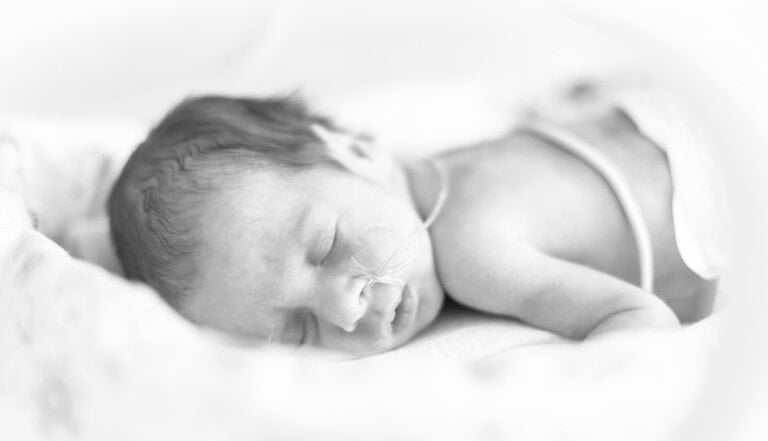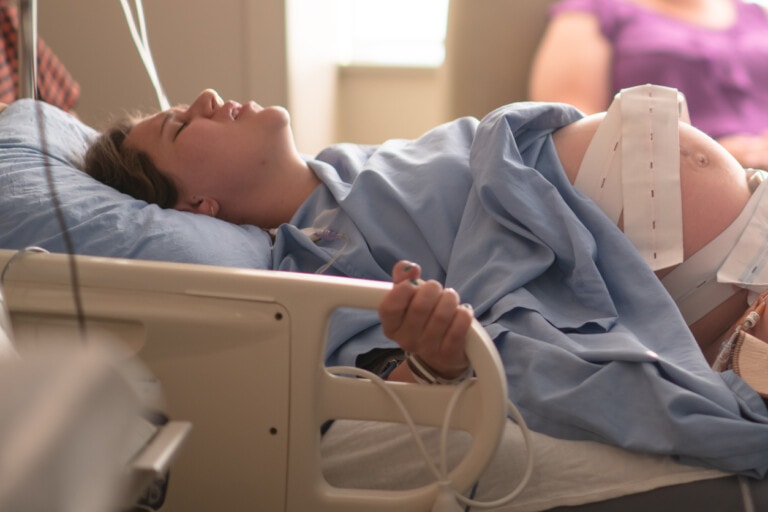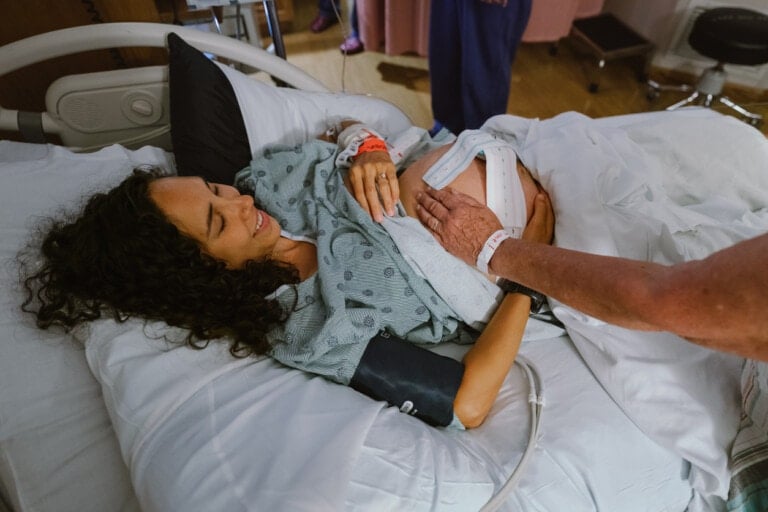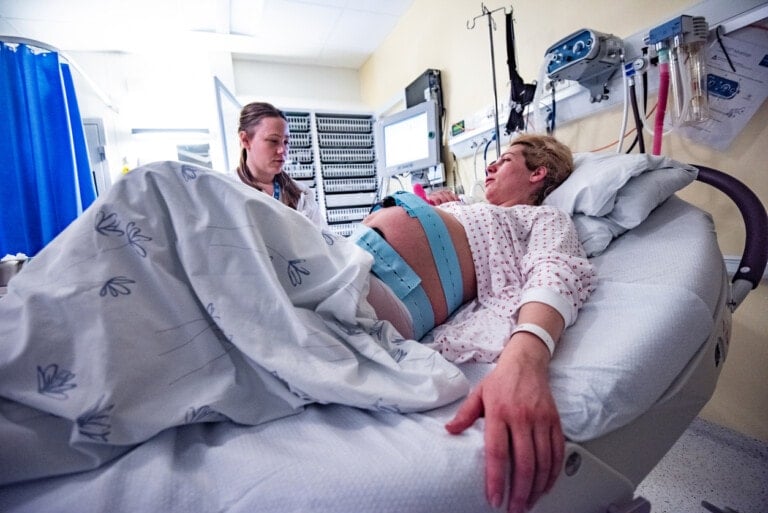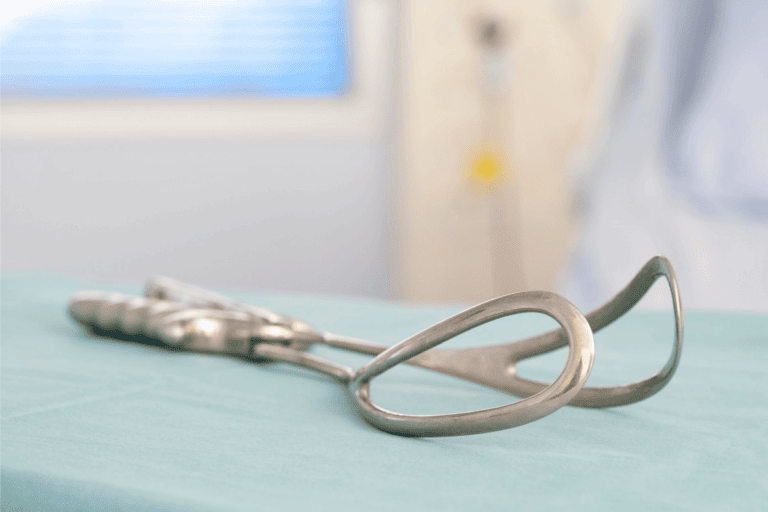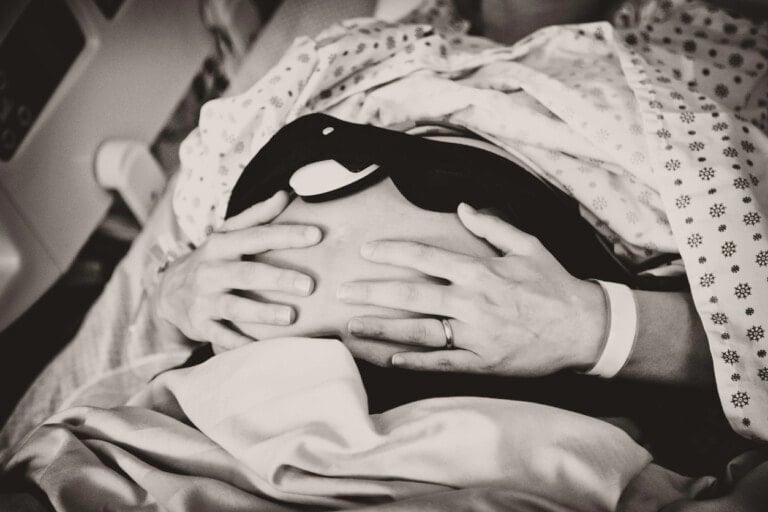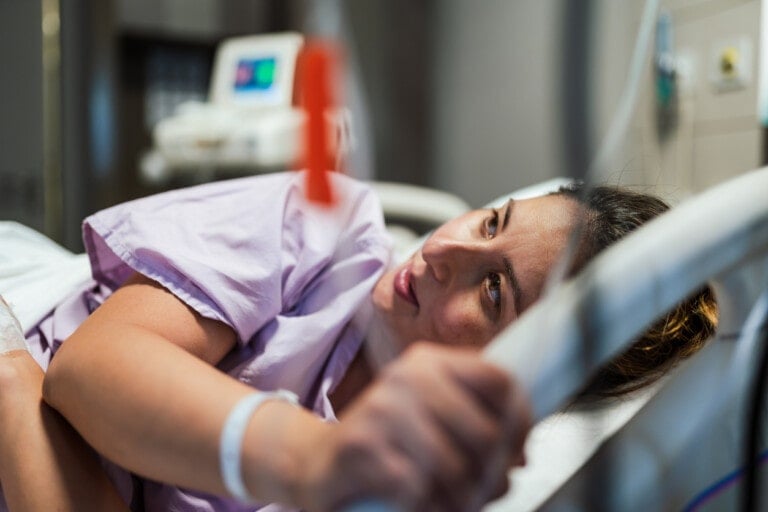There are so many different lists that tell you what you need to pack in your hospital bag for your labor and birth. As a doula, I have helped many clients prepare for their hospital stay. With this experience, I have created the ultimate hospital bag checklist that I promise will have everything you need!
NOTE: You should ensure your hospital bags are packed and in your car by 37 weeks.
I recommend leaving your hospital bags in your car at this time or sooner because you want to be prepared. It’s good to be ready just in case the OB-GYN or Midwife keeps you after a prenatal visit or sends you to the hospital because of an emergency. It’s always better to be safe than sorry!
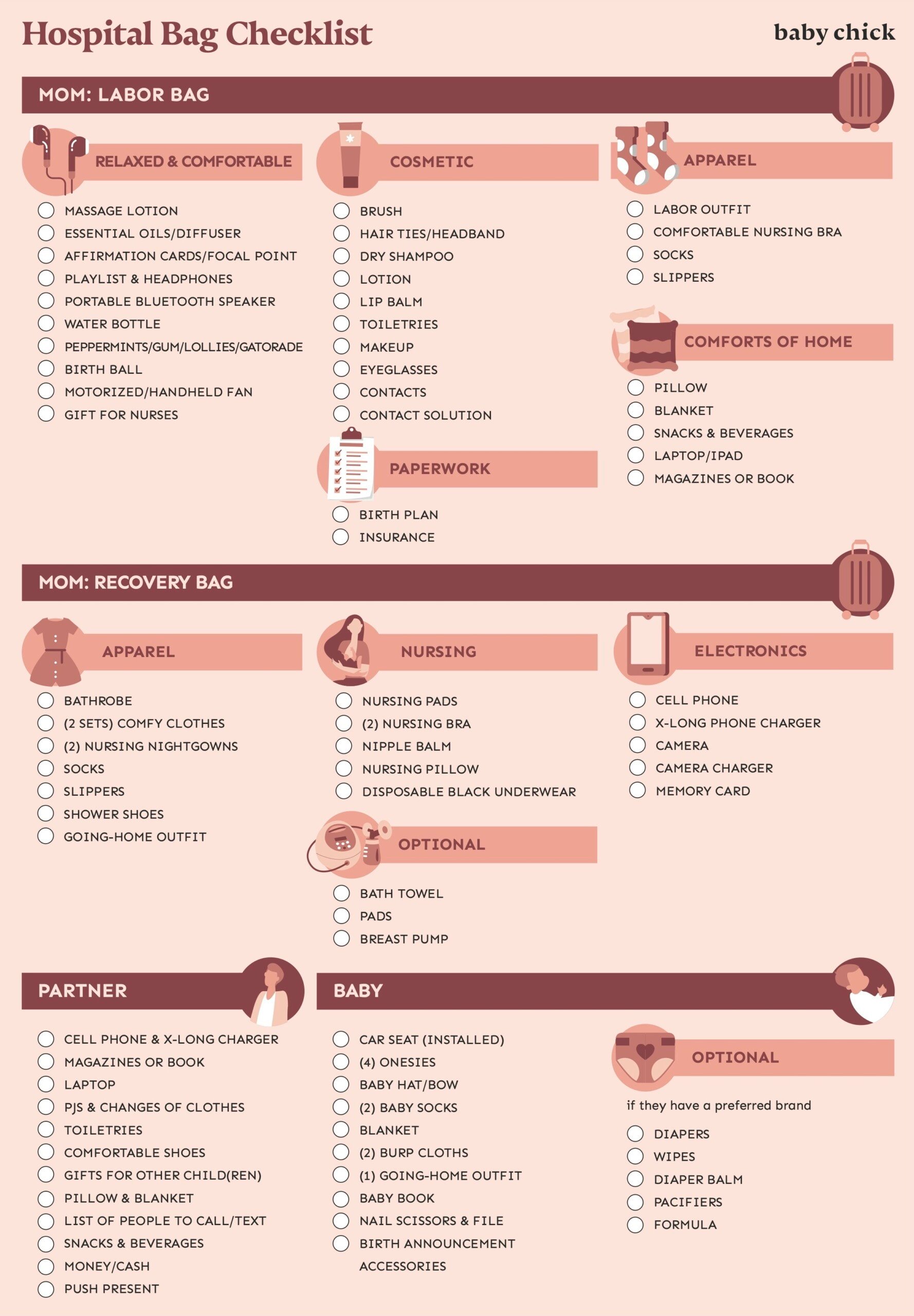
Below are different lists for the mom, dad/partner, and baby! Here is our hospital bag checklist—everything you’ll need at the hospital during labor, birth, and immediately postpartum.
Mama’s Hospital Bag Checklist:
I recommend that moms have two bags: one for labor and another for their recovery/postpartum room.
Labor Bag Checklist:
*Must-Haves:
Your birth plan (if you have one) and your insurance information.
Eyeglasses –
If you wear contacts, you should bring your glasses along with you. Some doctors and anesthesiologists ask you to remove your contacts before surgery if you need a C-section.
What You’re Going to Wear During Labor –
It will probably get a bit messy, so don’t bring anything too nice to wear in the hospital. If you aren’t sure of your options, here’s more information about what to wear at a hospital birth.
Massage Oil or Lotion –
If you want to be massaged during your labor, I recommend bringing massage oil or lotion so your partner or doula can massage you. (If you hired a doula, she will probably bring this with her in her doula bag.)
Birth Ball or Peanut Ball –
I think having a birth ball or peanut ball is a must in our hospital bag checklist. These can really help you during labor. A peanut ball is particularly great for women preparing to have an epidural. I highly recommend it. Just bring an air pump so your birth partner can inflate it if you didn’t come with it already inflated.
NOTE: Some hospitals have birth balls and peanut balls for you to use. Ask during your maternity hospital tour if they are available at your hospital.
Lip Balm –
Your lips can dry out quickly with all the deep breathing you will do in labor. Having some chapstick or lip balm will help.
Snacks and Drinks –
First, make sure that your doctor/hospital will allow this. Most of the time, they will only let you have ice chips at the hospital in labor, but they may have sugar-free popsicles there for you.
- Snacks to pack for labor and delivery
- Foods to eat (and not eat) in early labor
- Labor-Aide Recipe: The Drink to Fuel You Through Labor
Things to Help You Relax and Pass the Time:
If you are going to have an epidural:
Bring books, magazines, a card game, or your tablet or computer. They also have TVs in each L&D room so you can watch a show or a movie to help pass the time. I also recommend trying to take a nap. It’s great to catch up on as much rest as possible before the baby arrives.
If you want an unmedicated birth:
Create a birth playlist and bring music, a focal point (for example, it could be your baby’s ultrasound picture), massage lotions, a heating pad, rice socks to heat up so that you can put on your lower back, essential oils for labor and delivery, etc.
Headbands and/or Ponytail Holders –
If you have long hair, you may want it tied up since it can get in the way during labor. I recommend getting headbands and/or ponytail holders that don’t leave a kink in your hair. That way, if you want to take pictures with your hair down after birth, you won’t have a crease in your hair!
Music –
Take your Bluetooth speaker, a CD player and some CDs, or use your phone. Some hospitals provide CD players and Bluetooth speakers, so I would ask what they will have available in your room.
Camera, Charged Battery, Charger, and a Big Memory Card –
You never want to forget the day you first welcomed your baby into the world. Many parents take pictures with their phones, but if you have a nicer camera that you want to bring to capture this special time, bring it!
Cell Phone and Charger With a Long Cord –
You don’t know where the outlet will be, so bring an extra-long charging cord to keep your phone close if it needs to charge.
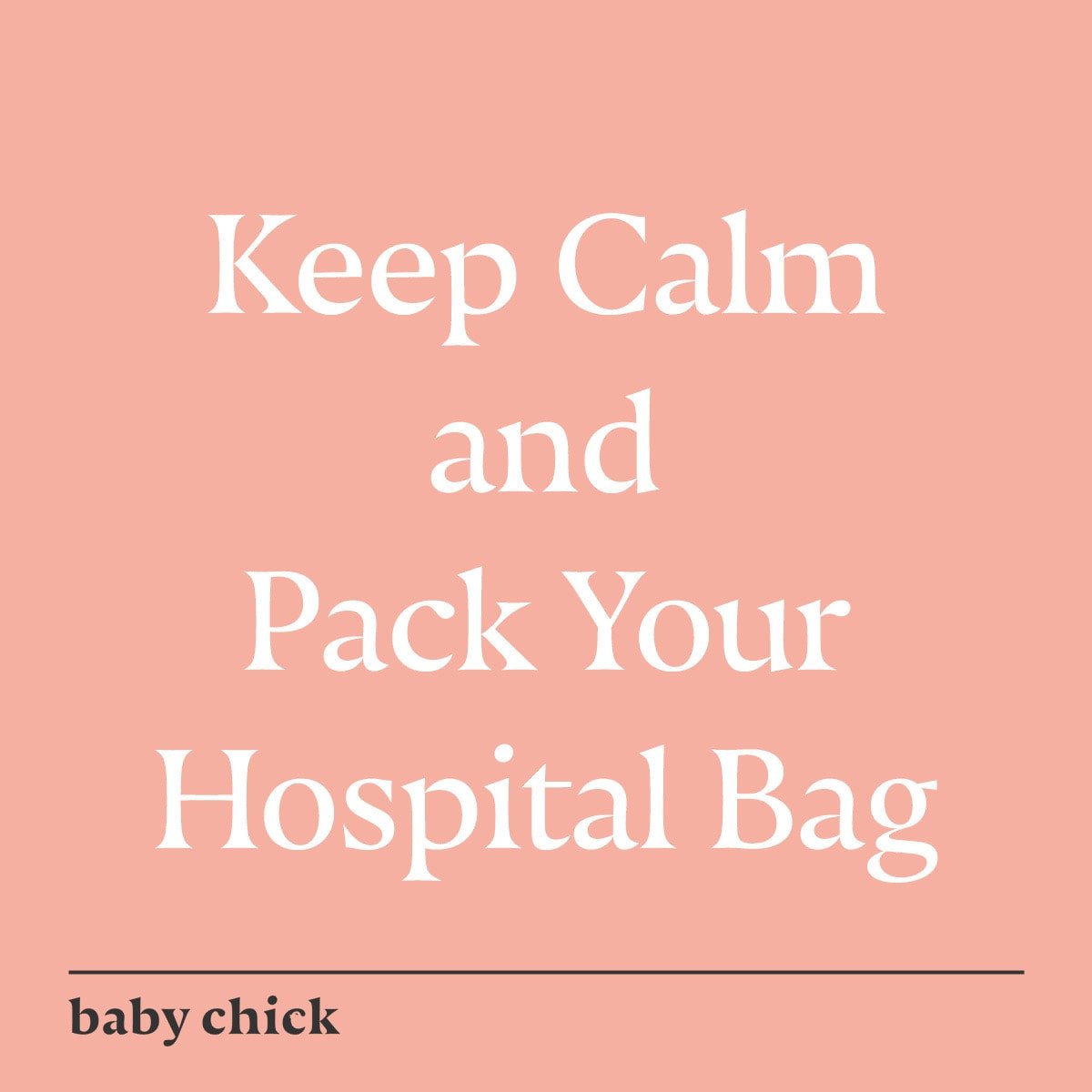
*Nice to Have But Not Necessities:
Backless Slip-on Slippers –
Your feet can get cold during labor, so it’s great to have some slippers that you can easily slip on and off. The hospital typically has non-skid socks (super sexy! 😉 ) that you can use if you prefer those instead.
Pillows –
The hospital might not have enough pillows to make you comfortable. Usually, each room has about two. And often, hospital pillows are very thin and uncomfortable. If you bring your own pillows (I would), ensure your pillowcase is not white. Otherwise, they could toss your pillowcase and pillow along with the rest of theirs, and your pillow will go missing. I would recommend adding it to your hospital bag checklist.
Baby Book –
After your baby is born, the nurse will get your baby’s footprints, so if you bring your baby book, she can also get those sweet footprints and/or handprints for your baby book!
Postpartum/Recovery Room Bag Checklist:
In addition to the below information, check out these resources:
- Postpartum Must-Haves for a Faster and Easier Recovery After Birth
- Postpartum Essentials for Mom and Baby
*Must-Haves:
Going-Home Outfit –
You’ll need loose, comfortable clothes to wear in the hospital and on the journey home. After the birth of your baby, you will still look about six months pregnant since your uterus still needs time to heal and return to its pre-pregnancy size. So, I recommend still bringing some soft maternity clothes for your trip back home.
Nursing Bras and/or Nursing Nightgowns –
If you had healthy labor and birth and your baby is doing well, you will probably only stay at the hospital for two or three days. I suggest bringing two or three nursing gowns or bras to make breastfeeding easier and remain comfortable during your stay. If you decide to wear your nursing bras, bring front-opening shirts so it’s easier to breastfeed.
Nursing Pads –
Bring a couple of packs (disposable or washable). Whether you plan to nurse or not, you’ll appreciate the support and leak protection.
Nipple Cream –
You want nipple cream to protect your nipples from chapping and cracking.
Your Toiletries –
Having smaller bottles or buying travel versions helps save space in your recovery bathroom. Bring the usual toiletries you need: hairbrush, toothbrush, toothpaste, shampoo, conditioner, body soap, razor, deodorant, face wash, makeup (if you’d like), makeup remover, lotion, hair ties, contact lens case, and solution, etc.
Postpartum Underwear or Disposable Underwear –
Don’t bring your nice, cute undies with you. You need big, cotton, breathable underwear. I recommend purchasing postpartum underwear. Some people even get Depends Silhouettes, so they can easily toss them after using them. The hospital will have disposable mesh undies with a large pad, which some women find handy and others find gross.
Bathrobe –
It’s nice to bundle up and feel covered and warm when getting out of bed or having guests in your hospital room.
Hair Dryer –
Snacks and Drinks –
Some hospitals have good food, and others don’t. If your hospital doesn’t have good food, and you don’t have someone to bring you food, bring some beverages and snacks to keep you nourished.
*Nice to Have But Not Necessities:
Nursing Pillow –
You can bring your Boppy pillow, My Breast Friend, or other breastfeeding pillows, depending on your preference.
Breast Pump –
If you plan to use a breast pump, I recommend bringing yours. Most hospitals have lactation consultants who visit each room to help you with breastfeeding and show you how to use your pump correctly.
Nipple Shields –
You don’t need to bring these with you. However, if you have some latching issues or if your nipples start to hurt or have inverted or flat nipples, the lactation consultant may recommend a nipple shield. You may be able to purchase them at the hospital as well.
Handouts –
If you received any booklets or handouts about starting breastfeeding, you can bring them as a reminder. The lactation consultants aren’t always there to see you, so these can help.
Bath Towel –
The hospital does have towels, but they are small and pretty thin. If you prefer to have your own thicker towels, you can bring your own.
Heavy Flow Pads –
The hospital also has large pads for you to use after birth (since you will be bleeding for several days, sometimes weeks, after giving birth). Bring the brand you prefer if you are picky about what type you want to wear.
Husband/Partner’s Hospital Bag Checklist:
In addition to the below information, have your partner read the following:
- Tips for dads during labor and delivery
- Best ways dads can help a new mom
- Ways dads can help with breastfeeding
*Must-Haves:
Extra Changes of Clothes –
I have had some dads/partners change their clothes even when their partner is still in labor. For example, they may think the room is too cold, so they put on a jacket or a long-sleeved shirt, or they sweat too much because they’re nervous or working hard too, so they need new shirts. So having some extra pairs of clean clothes is good to have on hand.
Comfortable Shoes –
They may be walking up and down the halls with you, running to get you ice chips, or going to find and talk to family. So having comfy shoes is essential.
Pillow –
For the same reason as you, they need something comfortable to sleep on. The pull-out couches aren’t the most comfortable, so it’s nice for them to have a good pillow.
Cell Phone and Charger –
Your partner should have been keeping track of your contractions on their phone with a contraction timer app, so be sure they have that downloaded as well. There are plenty of free ones.
Group Text or List of People to Call –
Before you go into labor, discuss with your partner all the people they need to notify once you are in labor. Some people do a group text, and others keep a list of names to get in touch with.
Snacks and Drinks –
You don’t want a dehydrated, hungry birth partner looking after you. If they bring some snacks and drinks, they can stay with you rather than leave the room to search for food! If they leave the room to find food and eat, they may not return quickly to help you. I tell my doula clients to bring a cooler to carry the drinks and snacks they want.
*Nice to Have But Not Necessities:
Motorized or Hand-Held Fan –
You may get overheated in labor, so it’s great if your partner has a fan to help you cool down. It can be a motorized or hand-held fan and may even have a mister, which can be very nice.
Money/Spare Change –
If you don’t have time to bring snacks, you will want some spare change for the vending machines. You both will probably be hungry after labor, and the hospital cafeteria might not be open once the baby is born. If no one can bring you food (which I would see if someone can pick something up for you), then having some change is helpful to get some snacks from the vending machine.
Pen and Paper –
If documenting things in a note on your phone is not your preference, bring something to take notes on. This will help if your nurse, doctor, or lactation consultant gives you any recommendations or advice. Also, you just gave birth and are recovering, so put him in charge of documenting important things.
Gifts for Other Children –
Make sure to have these ready when big brother or sister enters the room. A gift “from the baby” is always a good thing.
Push Present –
This way, they have the push present with them to give to you after the birth of your baby 😉
Baby’s Hospital Bag Checklist:
*Must-Haves:
Approved Car Seat –
Hospitals won’t let you leave without one, and the base needs to be installed properly in your car.
- 5 Considerations When Purchasing Baby’s First Car Seat
- 10 Car Seat Safety Tips That May Save Your Child’s Life
- The Best Infant Car Seats
A Going Home Newborn Outfit –
When purchasing a going-home outfit for your baby, consider what the weather might be like when your baby is born. Their outfit needs to be seasonally appropriate. Babies are sensitive to cold weather, so if it’s cold outside, bring a hat, snowsuit, or jacket to keep your baby warm. Don’t forget socks or booties. (Remove the snowsuit or jacket before placing your baby in a car seat.)
Warm Blankets –
The hospital will provide you with a baby blanket or two to swaddle your baby, but if you prefer a particular type of blanket, bring your own.
Announcement Items –
If you have a name badge or personalized blankets with your baby’s name, don’t forget to bring them so you can document and share with the world (or just your family) that your little one has arrived.
*Nice to Have But Not Necessities:
Onesies –
The hospital will give you some Gerber onesies while you are there, so all you really need is a going-home outfit for your baby. But if you prefer that your baby wear something else, bring two or three options.
Pacifiers –
If you decide to give your baby a pacifier, bring your own. Otherwise, they will charge you for theirs at the hospital, which is usually a little higher in price.
- The Pros and Cons of Pacifiers: Should You Give One to Your Baby?
- Pacifiers and Breastfeeding: What You Need to Know
- The Best Pacifiers for Breastfed Babies
- How to Clean Pacifiers and When to Replace Them
Burp Cloths –
Burp cloths are great for cleaning up any milk or if your baby spits up. But you can use the baby blankets that they give you.
I also recommend making sure there is extra room available in your hospital bags. Then, you can bring home everything that you get at the hospital. They are going to give you diapers, wipes, and more. Take as much as you can! They are charging you for it anyway. I hope this hospital bag checklist helps!













